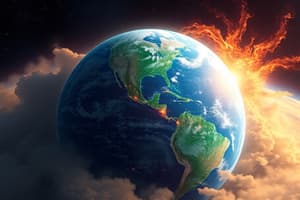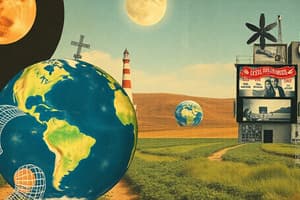Podcast
Questions and Answers
What is a consequence of climate change related to sea levels?
What is a consequence of climate change related to sea levels?
- Increase in freshwater lakes
- Sea level change (correct)
- Expansion of polar ice caps
- Decrease in global temperatures
Volcanic eruptions cause a warming effect by emitting large volumes of sulphur dioxide.
Volcanic eruptions cause a warming effect by emitting large volumes of sulphur dioxide.
False (B)
What greenhouse gas is released when tropical forests are cleared for cattle ranching?
What greenhouse gas is released when tropical forests are cleared for cattle ranching?
methane
The global average sea level has risen by about _____ cm since the late 19th century.
The global average sea level has risen by about _____ cm since the late 19th century.
Match the following climatic impacts with their descriptions:
Match the following climatic impacts with their descriptions:
What does climate variability refer to?
What does climate variability refer to?
Climate change only occurs over short time scales.
Climate change only occurs over short time scales.
What determines the temperature of the Earth?
What determines the temperature of the Earth?
The process of greenhouse gases absorbing heat energy is known as the __________.
The process of greenhouse gases absorbing heat energy is known as the __________.
Match the following climate forcing processes with their classification:
Match the following climate forcing processes with their classification:
Which of the following is classified as an external climate forcing process?
Which of the following is classified as an external climate forcing process?
Climate forcing processes can only result from human activities.
Climate forcing processes can only result from human activities.
What is the effect of adding more greenhouse gases to the atmosphere?
What is the effect of adding more greenhouse gases to the atmosphere?
Which of the following is an internal climate forcing process?
Which of the following is an internal climate forcing process?
The atmosphere plays a role in regulating the earth's climate by storing heat and energy.
The atmosphere plays a role in regulating the earth's climate by storing heat and energy.
What is the primary role of oceans in climate regulation?
What is the primary role of oceans in climate regulation?
The most potent greenhouse gas is ______.
The most potent greenhouse gas is ______.
Which of the following statements is NOT true about clouds?
Which of the following statements is NOT true about clouds?
Higher air temperatures can increase water ______ and melting of ice.
Higher air temperatures can increase water ______ and melting of ice.
Match the following internal climate forcing processes with their effects:
Match the following internal climate forcing processes with their effects:
Volcanic eruptions are classified as an external climate forcing process.
Volcanic eruptions are classified as an external climate forcing process.
Flashcards
How ice and snow affect climate?
How ice and snow affect climate?
The reflection of heat from the surface of ice and snow helps to cool the planet.
How does melting ice affect ocean temperatures?
How does melting ice affect ocean temperatures?
When ice melts into the ocean, it absorbs heat from the water, leading to variations in climate.
How do mountain ranges influence climate?
How do mountain ranges influence climate?
Mountain ranges can block clouds, creating drier regions on the downwind side.
How does deforestation affect greenhouse gas emissions?
How does deforestation affect greenhouse gas emissions?
Signup and view all the flashcards
How do volcanic eruptions impact global temperature?
How do volcanic eruptions impact global temperature?
Signup and view all the flashcards
Solar Energy Variations
Solar Energy Variations
Signup and view all the flashcards
Orbital Variations
Orbital Variations
Signup and view all the flashcards
Ocean's Role in Climate
Ocean's Role in Climate
Signup and view all the flashcards
Continental Drift's Impact on Climate
Continental Drift's Impact on Climate
Signup and view all the flashcards
Atmospheric Greenhouse Effect
Atmospheric Greenhouse Effect
Signup and view all the flashcards
Water Cycle and Climate
Water Cycle and Climate
Signup and view all the flashcards
Clouds' Impact on Climate
Clouds' Impact on Climate
Signup and view all the flashcards
Anthropogenic Climate Change
Anthropogenic Climate Change
Signup and view all the flashcards
Climate Variability
Climate Variability
Signup and view all the flashcards
Climate Change
Climate Change
Signup and view all the flashcards
Energy Balance
Energy Balance
Signup and view all the flashcards
Greenhouse Effect
Greenhouse Effect
Signup and view all the flashcards
Climate Forcing
Climate Forcing
Signup and view all the flashcards
Internal Climate Forcing
Internal Climate Forcing
Signup and view all the flashcards
External Climate Forcing
External Climate Forcing
Signup and view all the flashcards
Natural Causes of Climate Change
Natural Causes of Climate Change
Signup and view all the flashcards
Study Notes
Climate Variability
- Climate variability describes changes in the average state and other statistics, like extreme weather events, of the climate. These changes occur over various temporal and spatial scales greater than individual weather events.
- Variability can result from internal processes within the climate system (internal variability) or changes in natural or human-induced external factors (external variability).
What is Climate Change?
- Climate change is a shift in the pattern of weather, including changes in oceans, land surfaces, and ice sheets. These changes define Earth's local, regional, and global climates over decades or more.
Energy Balance
- Earth's temperature is regulated by a balance between incoming solar energy and outgoing energy.
- Global Energy Balance (GEB) considers Earth's stored energy: incoming solar energy versus energy released back into space.
The Greenhouse Effect
- Greenhouse gases (water vapor, carbon dioxide, methane, nitrous oxide) absorb and re-emit infrared radiation, which warms Earth's surface and lower atmosphere.
- Adding more greenhouse gases intensifies this effect, leading to a warmer planet.
Climate Forcing
- Climate forcing refers to any process influencing Earth's stored energy, either increasing or decreasing it. This leads to climate change.
- These forces can be external (e.g., variations in solar energy) or internal (e.g., ocean currents). A climate forcing can cause an imbalance in energy at the top of Earth's atmosphere, either due to external factors (e.g., natural changes in the sun's energy) or to human activities.
Climate Forcing Processes
- Internal climate processes operate within Earth (e.g., ocean currents, atmospheric circulations, water cycle)
- External climate processes operate from outside Earth (e.g., changes in solar energy, Earth's orbit)
Climate Change
- Climate change encompasses both natural (e.g., variations in solar energy, volcanic eruptions) and human-induced (e.g., greenhouse gas emissions) climate forcing processes.
External Climate Forcing Processes
- Variations in solar energy received from the sun.
- Changes in Earth's orbit around the sun.
Internal Climate Forcing Processes
- Oceans (influence moisture, heat distribution, CO2 absorption).
- Continental Drift (changing landmasses, ocean currents, wind patterns).
- Atmosphere (greenhouse gases, aerosols, temperature regulation).
- Water Cycle (evaporation, precipitation, temperature).
- Clouds (reflecting sunlight, trapping heat).
- Ice and Snow (reflecting heat, melting and sea levels).
- Land Surfaces (affecting cloud cover, water runoff, greenhouse gas exchange).
- Volcanic Eruptions (releasing particles, cooling the planet).
- Human Causes (anthropogenic activities influencing atmospheric composition and energy transfer).
Evidence of Climate Change
- Average global sea levels have risen approximately 16 cm since the late 19th century.
- Sea level rise is now accelerating, with estimates ranging from the last decade centred around 3.6 mm per year.
- Sea level uncertainty has decreased with more data collecting points.
Consequences of Climate Change
- Melting glaciers and ice sheets.
- Rising sea levels.
- Increased frequency of extreme weather events: heavy rainfall, drought, hurricanes.
- Decline in crop productivity.
- Ecosystem changes.
- Increased global temperatures
- Acidification of seawater.
Studying That Suits You
Use AI to generate personalized quizzes and flashcards to suit your learning preferences.




